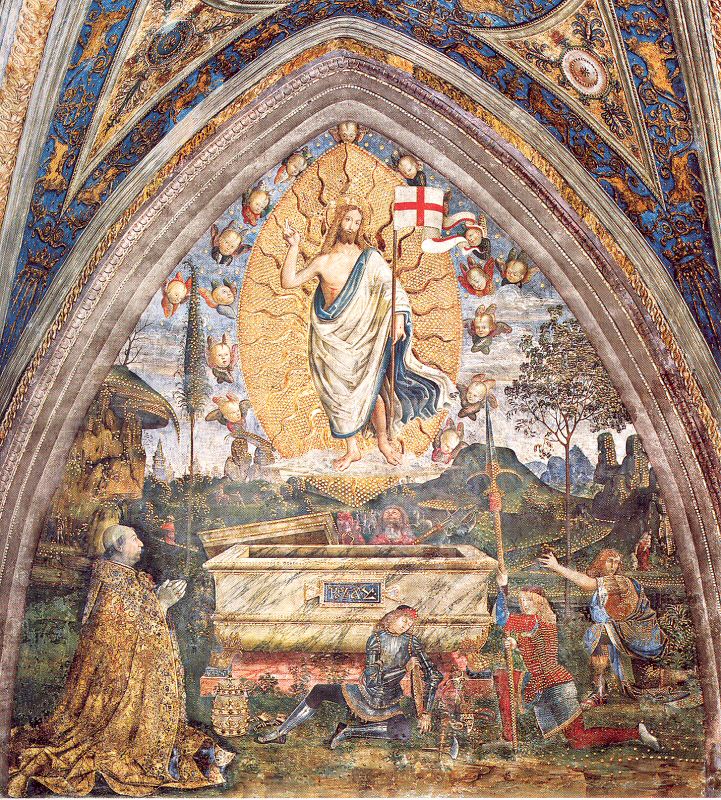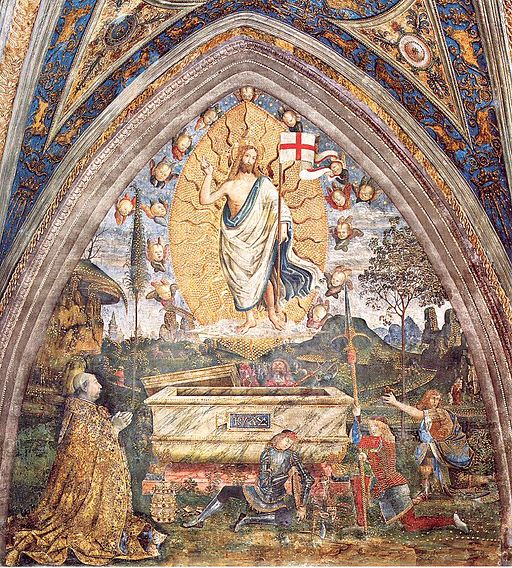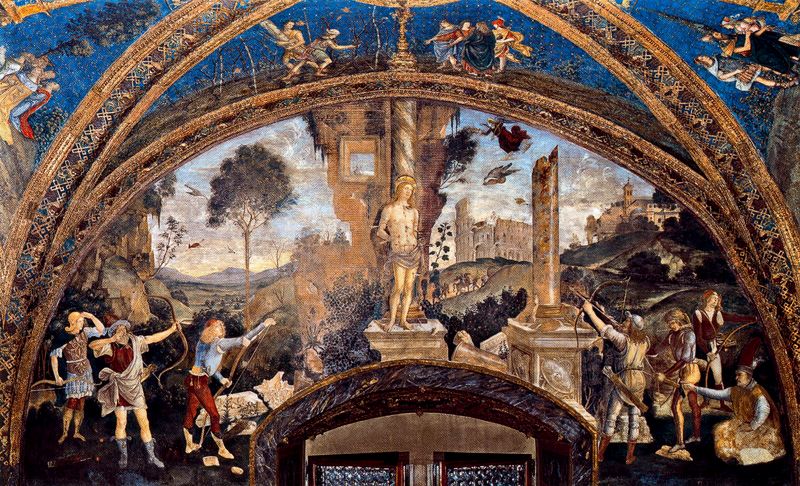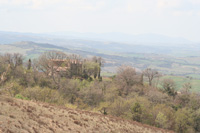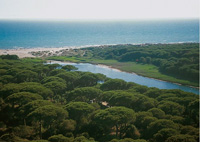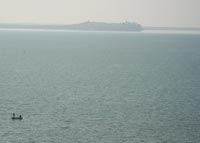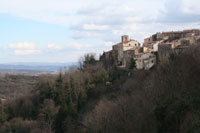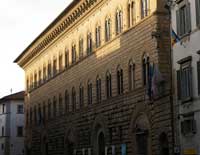| |
|

[0] Photo by sailko, licensed under the Creative Commons Attribution-Share Alike 3.0 Unported license.
[1] Bernardino di Betto (Benedetto), Italian painter called II Pinturicchio, was, like Perugino, a native of the district around Perugia and consequently open to the artistic currents common to the Umbrian region. His training and early career are completely unknown; even his date of birth is a matter of speculation. Usually considered to have been born around 1454 on the basis of ambiguous data given by Vasari, he was more likely born a few years later. He was thought by his contemporaries to have been a pupil of Perugino and to have had a share in Perugino's frescoes in the Sistine Chapel in the early 1480s. Critics have also assigned to him several paintings of a series depicting events in the life of St Bernardino of Siena (Pinacoteca, Perugia), firmly datable to around 1473. This attribution is impossible on chronological grounds if the correct date of his birth is about 1460.
The first actual notice for Pinturicchio is his inscription in the painters' guild in Perugia in 1481. There is another Perugian notice of 1481 concerning a work no longer extant. In the following year he received payments for a lunette in the Palazzo dei Priori in Perugia, his first securely datable work, although it is modest and uninformative stylistically.
The important frescoes for the Bufalini family in the Roman church of Santa Maria in Aracoeli are not documented, but may date from the late 1480s. They were produced for an Umbrian patron from Citta di Castello and depict scenes from the life of St Bernardino. Only with the decorations of the so-called Borgia apartments in the Vatican Palace, made for the Borgia Pope Alexander VI (1492-1503) soon after the Pope took office and probably finished by 1495, do we have another firmly dated work.
By the 1490s, then, his life and work are more thoroughly traceable. In 1492 Pinturicchio was summoned to Orvieto, where he painted two Prophets and two of the Doctors in the Cathedral. He then returned to Rome, and was employed by Pope Alexander VI (Borgia) to decorate a recently completed suite of six rooms, the Appartamenti Borgia in the Vatican. These rooms now form part of the Vatican library, and five still retain a series of Pinturicchio frescoes. The Umbrian painter worked in these rooms till around 1494, assisted by his pupils, and not without interruption. His other chief frescoes in Rome, still existing in a very genuine state, are those in the Bufalini Chapel in the southwest sector of Santa Maria in Ara Coeli, probably executed around 1484-1486. On the altar wall is a grand painting of St Bernardino of Siena between two other saints, crowned by angels; in the upper part is a figure of Christ in a mandorla, surrounded by angel musicians; on the left wall is a large fresco of the miracles performed by the corpse of St Bernardino, which includes portraits of members of the sponsoring Bufalini family.
One group of three females, the central figure with a child at her breast, recalls the grace of Raphael's second manner. The composition of the main group round the saint's corpse appears to have been suggested by Giotto's painting of St. Francis on his bier found in Santa Croce at Florence. On the vault are four noble figures of the Evangelists, usually attributed to Luca Signorelli, but more likely, as with the rest of the frescoes in this chapel, by the hand of Pinturicchio. On the vault of the sacristy of Santa Cecilia in Trastevere, Pinturicchio painted the Almighty surrounded by the Evangelists.
In 1501 he frescoed the Baglioni Chapel in Santa Maria Maggiore in his native town of Spello. In that year he also held political office in Perugia. By 1502 Pinturicchio had obtained the commission to fresco the Piccolomini Library, a large appendage to the Sienese Cathedral. The actual painting took place between 1505 and 1507.
There are a few surviving easel paintings by Pinturicchio in various museums like The Crucifixion in the Borghese Gallery, Rome.
In Siena - where he finally settled, married, had children, and died - he had other important commissions for the Cathedral, for the Church of San Francesco, and for Pandolfo Petrucci, the chief citizen of the city. Throughout his life, Pinturicchio was never recorded in Florence. Although we might easily assume a brief trip or trips there, a sympathy for the progressive art occurring in the Tuscan capital is completely absent from his work. In this respect, he is unlike other leading Umbrian painters, such as Piero della Francesca, Perugino, Signorelli, and Raphael, who were open to such influences.
Images source http://cgfa.acropolisinc.com/pinturicchio/index.html, Public Domain, https://commons.wikimedia.org/w/index.php?curid=8173941
|

In October 2002 a major exhibition opened at the Palazzo Ruspoli in Rome, The Borgias: The Art of Power. It drew together more than two hundred artworks from museums around the world. In addition to Pinturicchio, who decorated the Borgia apartments in the Vatican, and who painted Giulia Farnese as the Virgin Mary for Alexander’s bedchamber, other artists who met the Borgias, and whose works were part of the exhibition, included Michelangelo, Titian and Bellini. One room was dedicated solely to Cesare Borgia’s military costumery.
"The Borgias" was part of a huge cultural project that kicked off in early 2002, dedicated to Lucrezia Borgia. The exhibition boasted the hand of scenographer Ezio Frigerio and relied on a conspicuous number of works on loan from 42 European and international museums.
|
| |
|
|
| |
|
|
 |
| |

Podere Santa Pia is tucked away in the Tuscan countryside yet close to surrounding villages and towns. Close to the Tyrrhenian coast but set in an oasis of green and abundant nature, Podere Santa Pia combines the best of this region's original qualities. The Maremma is renowned for its culinary and wine traditions. Just some of the towns in the area which are worth a stroll around and more include Arcidosso, Castel del Piano, Roccalbegna, Semproniano and the spa town of Saturnia. Experience the best of Tuscany on day tours to Montalcino, Montepulciano, Scansano and the surreal beauty of the Val D'Orcia, and enjoy wine tastings of the famous Brunello, Montecucco and Montepulciano wines. For garden-lovers and those who just enjoy the iconic views of the Tuscan countryside, iris Origo's wonderful Villa La Foce is nearby. The villa, one of the great private gardens of Italy, lies on a hill overlooking this beautiful and unspoiled part of Tuscany.
Holiday houses in Tuscany | Podere Santa Pia | Residency in Tuscany for writers and artists
|
| |
|
|
|
|
|
|
|
|
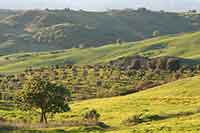
|
Podere Santa Pia |
|
Pienza and the Val d'Orcia |
|
Century-old olive trees, between Podere Santa Pia and Cinigiano |
| |
|
|
|
|
|
|
|
|
|
Marina di Grosseto |
|
Lago Trasimeno |
|
Scansano |
| |
|
|
|
|
|
|
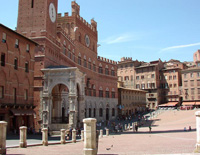
|
|
|
Palazzo Medici Riccardi, Florence |
|
Siena, Palazzo Publicco |
|
Florence, Duomo |
| |
|
|
|
|
|
|
|
 |
Podere Santa Pia is tucked away in the Tuscan countrysidewith splendid views up to the Tyrrhenian coast and Monte Christo, and yet close to surrounding villages and towns.
|
|
The Vatican Museums
The Vatican Museums contain a vast store of artworks which range from the ancient to the contemporary, including the world famous Sistine Chapel. Touring the Vatican Museums can easily take two hours or more, so it is imperative that you have an action plan when you visit. Here is a list of the top attractions to look for when you visit the Vatican Museums. For a complete list, visit the Vatican Museums website.
The Vatican picture gallery has the largest of Pinturicchio's panels — the Coronation of the Virgin, with the apostles and other saints below. Several well-executed portraits occur among the kneeling saints. The Virgin, who kneels at Christ's feet to receive her crown, is a figure of great tenderness and beauty, and the lower group is composed with great skill and grace in arrangement.
1. The Sistine Chapel
The Sistine Chapel is one of the main attractions to visit in Vatican City. The highlight of a visit to the Vatican Museums, the famous chapel contains ceiling and altar frescoes by Michelangelo and is considered one of the artist's greatest achievements. But the chapel contains more than just works by Michelangelo; it is decorated from floor to ceiling by some of the most famous names in Renaissance painting.
The Sistine Chapel is the last room that visitors see when touring the Vatican Museums.
The grand chapel that is known around the world as the Sistine Chapel was built from 1475-1481 at the behest of Pope Sixtus IV (the Latin name Sixtus, or Sisto (Italian), lending its name to "Sistine"). The monumental room measures 40.23 meters long by 13.40 meters wide (134 by 44 feet) and reaches 20.7 meters (about 67.9 feet) above the ground at its highest point. The floor is inlaid with polychrome marble and the room contains an altar, a small choristers' gallery, and a six-paneled marble screen that divides the room into areas for clergy and congregants. There are eight windows lining the upper reaches of the walls.
Michelangelo's frescoes on the ceiling and the altar are the most famous paintings in the Sistine Chapel. Pope Julius II commissioned the master artist to paint these parts of the chapel in 1508, some 25 years after the walls had been painted by the likes of Sandro Botticelli, Ghirlandaio, Perugino, Pinturrichio, and others.
2. The Raphael Rooms
The four Stanze di Raffaello ("Raphael's rooms") in the Palace of the Vatican form a suite of reception rooms, the public part of the papal apartments. They are famous for their frescoes, painted by Raphael and his workshop. Together with Michelangelo's ceiling frescoes in the Sistine Chapel, they are the grand fresco sequences that mark the High Renaissance in Rome.
The Stanze, as they are invariably called, were originally intended as a suite of apartments for Pope Julius II. He commissioned Raphael, then a relatively young artist from Urbino, and his studio in 1508 or 1509 to redecorate the existing interiors of the rooms entirely. It was possibly Julius' intent to outshine the apartments of his predecessor (and rival) Pope Alexander VI, as the Stanze are directly above Alexander's Borgia Apartment. They are on the third floor, overlooking the south side of the Belvedere Courtyard.
3. The Borgia Apartments
The artist Pinturicchio painted the rich frescoes in the Borgia Apartments, the area on the first floor where Pope Alexander VI lived. The rich, colorful frescoes depict scenes from Egyptian and Greek mythology and speak to lavishness of the Vatican Palace.
Most of the rooms are now used for the Collection of Modern Religious Art, inaugurated by Paul VI in 1973. This Collection hosts about 600 accumulated works of painting, sculpture and graphic, through donations of contemporary Italian and foreign artists and includes works by Gaugin, Chagall, Klee and Kandinskij.
4. The Gallery of Maps
When the Renaissance Pope Gregory XIII (1572-85) decided to commemorate a spacious Vatican gallery, he commissioned the Dominican friar and cosmographer Egnizio Danti. In conscious imitation of the ancient Roman custom of decorating the walls of state buildings with geographical images, Danti designed 40 richly embellished maps of Italian port cities in two parallel lines along the walls.
This incredible hall has maps frescoed on both walls showing various parts of Italy from the 16th century. These historically significant frescoes of the Italian cities, the countryside, and geographical features, such as the Apennine Mountains and the Tyrrhenian Sea, are a joy to inspect, as is the gallery's sumptuously decorated coffered ceiling.
5. The Cappella Nicolina
Named for Pope Nicholas V, who worshipped here, this chapel is located in one of the oldest parts of the papal palace. In 1447, or perhaps earlier, Fra Angelico was in Rome, where he painted the private chapel of Pope Nicholas V with scenes from the lives of St Lawrence and St Stephen, frescoes which sum up the whole trend of his work. They possess a logical realism in their perspective settings, clarity of scale and narrative content, and restraint in their vigour. The colour is limpid, but with sufficient use of chiaroscuro to give substance to the figures; the use of continuous representation is kept to a minimum by the division of the scenes through differences in their architectural setting, but nowhere is the search for realism in the use of lighting effects allowed to destroy the unity of the whole, or the sense of the plane of the wall.
Fra Angelico | Frescoes in the Cappella Niccolina of the Palazzi Pontifici in Vatican (1447-49)
6. Greek and Roman Antiquities
The Pio-Clementine and the Gregorian Profane Museums are dedicated to treasures of antiquity. Highlights include the Apollo del Belvedere, "a supreme ideal" of classical art; the Laocoön, a large marble composition from 1st century A.D.; the Belvedere Torso, a Greek sculpture from the 1st century B.C.; the Discus Thrower, a 5th century B.C. representation of an discus athlete in movement; and a collection of Roman mosaics. |
This article incorporates material from the Wikipedia article Borgia Apartment published under the GNU Free Documentation License.
Wikimedia Commons has media related to Borgia Apartment. |
|
|






